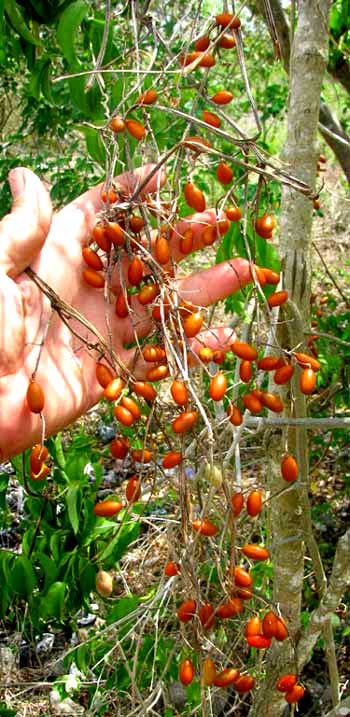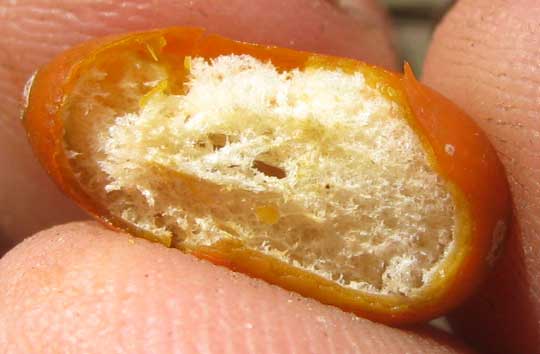Excerpts from Jim Conrad's
Naturalist Newsletter
from the April 10, 2011 Newsletter issued from Hacienda Chichen Resort beside Chichén Itzá Ruins, central Yucatán, MÉXICO; limestone bedrock, elevation ~39m (~128ft), ~N20.676°, ~W88.569°
LITTLE ORANGE CUCUMBER-THINGIES

Dangling from trees at the side of the road south of Pisté I spotted the strange cluster of fruits shown at the right:
The fruit cluster dangled from dead, dried-up, twining vines on which the leaves had long fallen off. I opened up a 2/3-inch long (1.7cm) fruit and saw what's at the bottom of this page.
Note the scar at the far left. That's where the calyx and corolla fell off, so this fruit has developed from an " inferior ovary" -- an ovary with floral parts arising atop it, not at its base. Also, inside the little fruit it's spongy, as in a luffa gourd.
So, since this was a non-woody vine whose flowers produce inferior ovaries, and fruits with interiors like certain gourds, I figured that this was a member of the Squash/Cucumber/Gourd Family, the Cucurbitaceae, even though I'd never seen a squash, cucumber or gourd like these little orange thingies.
Knowing the family, it wasn't hard to find out which species this was by Googling all the cucurbitaceous species I didn't recognize listed for this area. The vine turned out to be CAYAPONIA RACEMOSA, sometimes given the name Mountain Melonleaf, but here in the Yucatán we have no mountains, and lots of vines have leaves similar to those of melons, so I prefer just to call it Cayaponia, which is pretty enough a name.

This species is native to the humid lowland tropics from northeastern Mexico and southern Florida south through Central America and the Antilles into northern South America. However, its flowers and fruits are seldom photographed and there's not much information available about it, so I'm tickled to contribute what we have here.